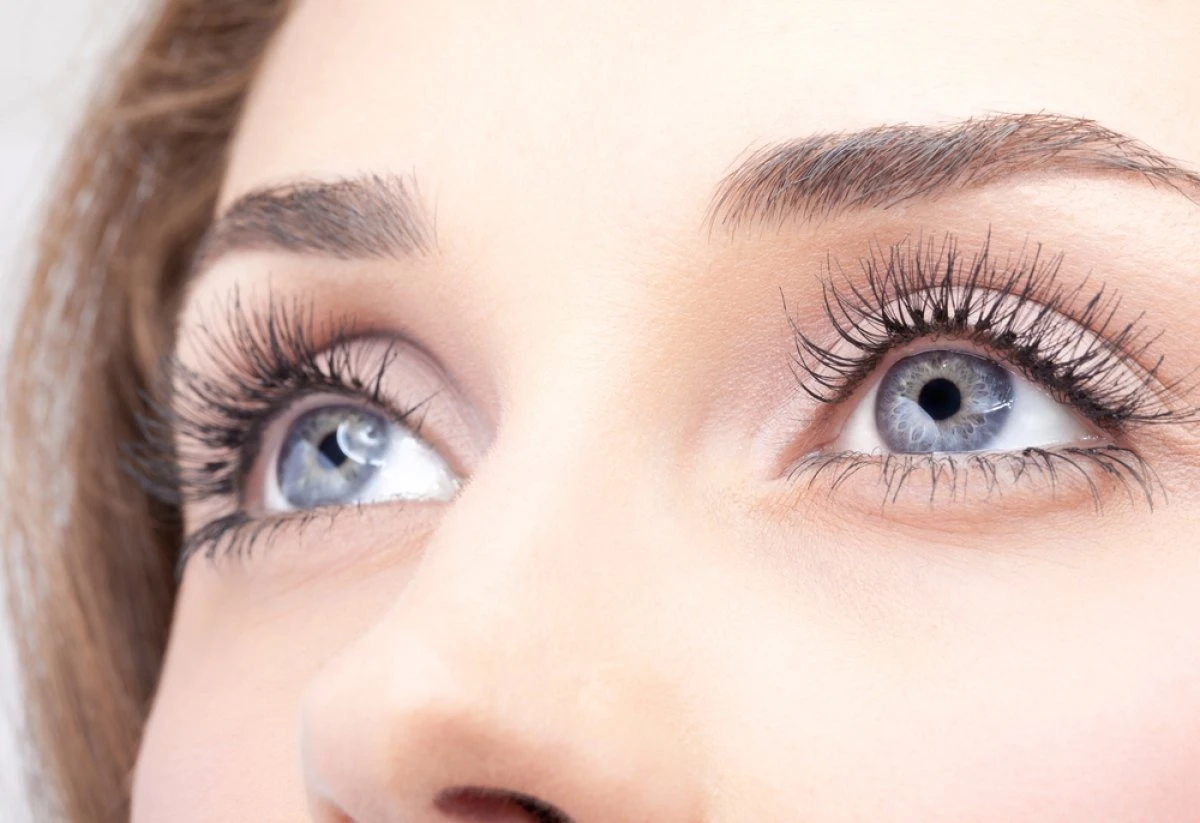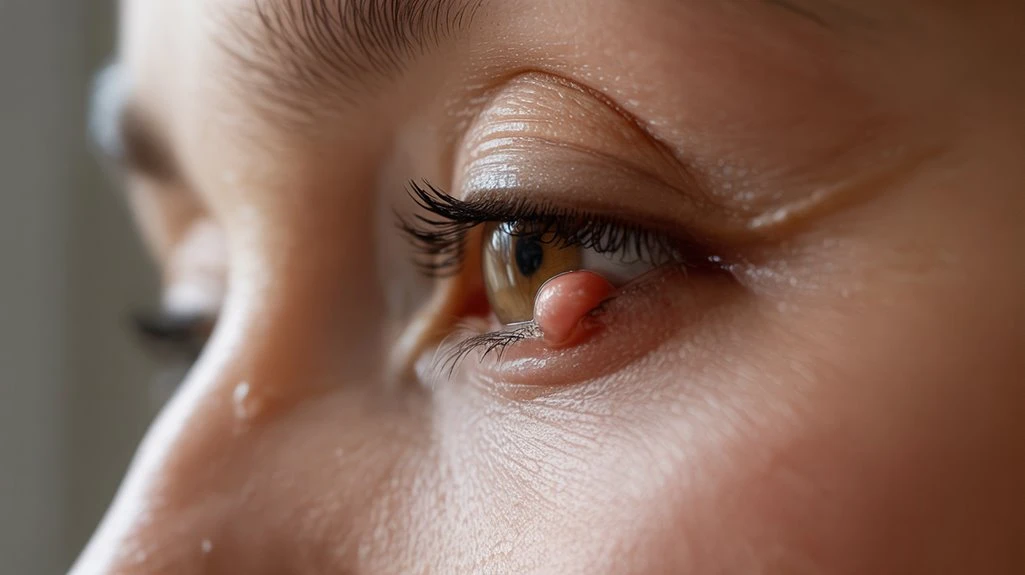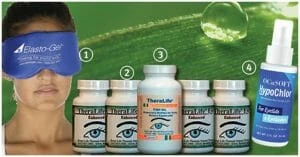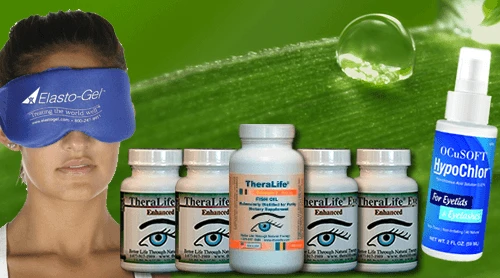TheraLife stands out as a unique provider of oral eye treatment care, offering products that address various eye conditions, including hardened chalazions. While a hardened chalazion generally does not disappear naturally due to chronic inflammation and fibrosis, TheraLife‘s products can support your body’s immune response more effectively, potentially alleviating symptoms or preventing further complications. Unlike traditional methods that may only provide temporary relief, TheraLife’s holistic approach focuses on long-term eye health.
Their flagship product line not only targets chalazions but also provides relief for other eye conditions such as blepharitis, dry eyes, and uveitis. By incorporating natural anti-inflammatory ingredients and promoting overall eye wellness, TheraLife empowers customers to manage their eye health proactively. Through a combination of scientifically-backed formulas and a commitment to addressing the root causes of eye disorders, TheraLife offers a comprehensive solution for those seeking to improve their eye health without invasive procedures. If you’re experiencing persistent eye issues, exploring TheraLife’s offerings might provide the relief and care you need.
Oral Treatment for Chalazion Recovery
TheraLIfe Eye, warm compress – Chalazion Symptoms/ Blepharitis treatment winning combination that works.
Add To Cart
Key Takeaways
- Hardened chalazia are less likely to resolve naturally compared to softer, recent lesions.
- Chronic or firm chalazia often persist due to fibrosis and may require medical intervention.
- Warm compresses and eyelid massage can help but are less effective on longstanding, hardened nodules.
- Lack of size reduction or increasing firmness suggests the need for specialist evaluation.
- Spontaneous resolution is uncommon for hardened chalazia; ophthalmologist assessment is recommended if no improvement occurs in several weeks.
Understanding What a Chalazion Is
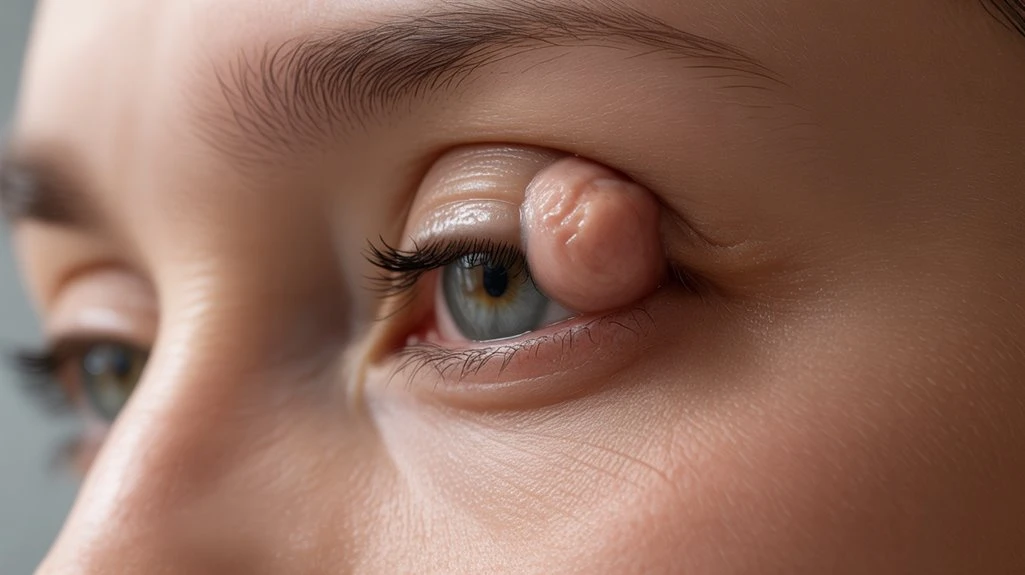
A chalazion is a localized, painless swelling that develops within the eyelid due to the obstruction and subsequent inflammation of a meibomian gland. You’ll typically notice chalazion symptoms such as a firm, round nodule on your eyelid, mild tenderness, and sometimes minimal redness or swelling. Unlike styes, chalazia rarely cause significant pain or acute infection. Vision might be blurred if the lesion is large enough to press against your eye. For effective chalazion prevention, maintain good eyelid hygiene, regularly clean your eyelids, and avoid touching your eyes with unwashed hands. Removing makeup thoroughly and managing underlying conditions like blepharitis can further lower your risk. Early recognition of chalazion symptoms and prompt self-care can help prevent progression and reduce the likelihood of recurrence. Warm compresses are an effective first-line treatment for chalazion, facilitating drainage of gland contents and reducing inflammation.
Causes Behind Chalazion Hardening
When a chalazion persists over time, the trapped meibomian gland secretions undergo gradual thickening and organization due to chronic inflammation. This process leads to the formation of a firmer nodule as inflammatory cells stimulate fibrosis within the gland. Certain risk factors, such as underlying blepharitis, rosacea, or a history of chalazia, increase your susceptibility to persistent, hardened lesions. Lifestyle choices also play a role—poor eyelid hygiene, frequent eye rubbing, or inadequate makeup removal can exacerbate gland blockage. Regular eyelid cleansing is essential for maintaining hygiene and preventing chalazion hardening or recurrence.
| Risk Factor | Pathophysiological Effect | Preventive Action |
|---|---|---|
| Blepharitis | Increases inflammation | Practice lid hygiene |
| Rosacea | Alters meibum quality | Control skin condition |
| Eye Rubbing | Promotes blockage | Avoid mechanical trauma |
Recognizing these contributors may help limit chalazion hardening and recurrence.
Typical Healing Process of Chalazia
Although chalazia may cause discomfort and visible swelling, most resolve spontaneously within several weeks as the body’s immune response gradually clears the obstructed glandular material. You might encounter chalazion myths that suggest aggressive intervention is always necessary, but evidence shows that conservative management is often effective. Understanding the typical healing process can help you avoid common treatment misconceptions and unnecessary anxiety. Here’s what you can expect during natural chalazion resolution:
- Gradual Reduction: The lump softens and decreases in size over time.
- Decreased Redness: Inflammatory signs, such as redness and tenderness, slowly subside.
- Restoration of Eyelid Contour: The eyelid regains its normal structure as swelling resolves.
- Low Recurrence Risk: With proper eyelid hygiene, recurrence rates remain low.
Regular monitoring of chalazia size and symptoms is recommended, and consultation with a specialist is advised for persistent cases. Appreciate the body’s capacity for gradual healing.
Factors That Affect Natural Resolution

When evaluating natural resolution of a hardened chalazion, you should consider its size, duration, and your immune system’s effectiveness. Larger or longstanding lesions are less likely to resolve spontaneously. Consistent eyelid hygiene also plays a critical role in preventing recurrence and supporting recovery. In some cases, a hot compress can aid in softening the hardened chalazion, promoting drainage and healing.
Chalazion Size and Duration
Since chalazion size and duration play essential roles in their natural resolution, it’s important to recognize that larger or long-standing lesions are less likely to resolve spontaneously.
When you notice chalazion symptoms—such as a painless, firm eyelid lump—timely chalazion diagnosis is vital. Smaller chalazia, especially those present for only a few weeks, have a higher chance of disappearing without intervention.
In contrast, hardened or chronic lesions often require medical evaluation and may persist without treatment.
Consider these key factors:
- Size: Smaller chalazia resolve more readily than larger ones.
- Duration: Recent lesions are more likely to regress naturally; chronic cases tend to persist.
- Consistency: Soft lesions respond better to conservative care, while hardened nodules often don’t.
- Early diagnosis: Prompt recognition and chalazion diagnosis can influence outcomes.
In addition to size and duration, implementing effective non-surgical treatment options like warm compresses and lid hygiene can enhance the chances of natural resolution for smaller chalazia.
Immune System Response
While chalazion resolution depends on several factors, your immune system’s response plays a pivotal role in clearing the lesion naturally. A robust immune response targets residual inflammatory cells and debris within the blocked meibomian gland.
Your natural defenses, including white blood cells and cytokine signaling, help break down the granulomatous tissue and facilitate resorption. If your immune function is efficient, the chalazion is more likely to regress without medical intervention.
Conversely, if your immune response is compromised—due to systemic illness or immunosuppression—the lesion may persist or even worsen. Age, underlying systemic conditions, and nutritional status can also modulate your body’s natural defenses, affecting chalazion resolution.
It is important to note that Meibomian Gland Dysfunction may contribute to chalazion formation by leading to blocked glands, affecting the natural resolution process.
Ultimately, your immune system’s efficiency determines how quickly and effectively a hardened chalazion resolves on its own.
Personal Hygiene Habits
Although chalazion resolution primarily relies on your immune response, personal hygiene habits greatly influence the natural healing process.
Proper eyelid care reduces the risk of secondary infection and prevents further blockage of the meibomian glands. Evidence-based practice emphasizes meticulous eyelid hygiene to facilitate spontaneous resolution and minimize complications.
To optimize your chalazion’s chance of resolving naturally, focus on these key personal hygiene steps:
- Wash hands thoroughly before touching your eyes or eyelids.
- Cleanse eyelids daily using a gentle, hypoallergenic cleanser to remove debris and oil.
- Avoid eye cosmetics and contact lenses during active inflammation to reduce contamination risk.
- Use a clean, warm compress on the affected eyelid to promote drainage and soften the lesion.
Consistent eyelid care supports your body’s natural healing mechanisms. Regular monitoring of changes in chalazion characteristics is crucial to assess treatment effectiveness and detect any signs of infection or worsening symptoms.
Signs Your Chalazion May Not Go Away on Its Own
If your chalazion persists for several weeks, becomes increasingly firm, or shows no reduction in size, these are indications it may not resolve spontaneously. It’s a common chalazion myth that all lumps on the eyelid will disappear naturally; in reality, some require medical intervention—especially if the lesion hardens or causes visual disturbance. Be alert for these clinical warning signs:
| Symptom | Clinical Significance |
|---|---|
| Persistent swelling | May indicate chronic granuloma |
| Increasing firmness | Suggests fibrosis, less likely to resolve |
| No size reduction | Implies ongoing blockage |
| Visual disturbance | Risks corneal involvement |
Don’t fall for chalazion misconceptions that prolonged duration is harmless. If you notice these features, it’s crucial to seek evaluation by an ophthalmologist. Early identification of non-resolving chalazia can prevent complications and guide appropriate treatment. Interestingly, Meibomian gland dysfunction is often the underlying cause of chalazia, leading to blockages that result in swelling and inflammation.
At-Home Care and Warm Compresses
To support resolution of a hardened chalazion, you should apply effective warm compress techniques for at least 10–15 minutes, several times daily. Combine this with gentle eyelid massage to promote drainage, and maintain safe eyelid hygiene practices to minimize recurrence. These evidence-based strategies can enhance symptom relief and optimize healing. Consistent use of warm compresses, such as the Bruder Moist Heat Eye Compress, can provide standardized therapy and improve blood circulation to aid in the healing process.
Effective Warm Compress Techniques
Since consistent heat application is crucial in managing a hardened chalazion, warm compresses remain a mainstay of at-home care.
Applying a warm compress promotes localized vasodilation, softening the chalazion and facilitating drainage. This technique also reduces eyelid swelling and discomfort, hastening resolution. For best results, you should use evidence-based methods to guarantee safety and efficacy.
- Soak a clean washcloth in water heated to around 40–45°C (104–113°F) to avoid burns and maximize therapeutic benefit.
- Wring out excess water and place the compress gently over the closed eyelid for 10–15 minutes.
- Repeat this process 3–4 times daily, reheating the compress as needed to maintain warmth.
- Use a fresh, clean cloth for each session to prevent secondary infection.
In addition to the compresses, incorporating lid massage techniques can further facilitate the drainage of blocked meibomian glands, thereby enhancing the overall effectiveness of the treatment.
These steps maximize the impact of warm compress therapy.
Gentle Eyelid Massage Tips
Following warm compress application, gentle eyelid massage further assists in mobilizing the contents of a hardened chalazion. For ideal timing, perform the massage immediately after each compress session, when the affected tissue is most pliable.
Use clean hands and apply gentle pressure with your fingertip, moving in a circular motion over the closed eyelid, directly above the chalazion. Limit the massage to 1–2 minutes to avoid irritation.
Evidence suggests that gentle, consistent massage can help promote drainage by encouraging liquefaction and movement of trapped lipids within the meibomian gland. Avoid excessive force, as this may worsen inflammation or cause tissue injury.
If you experience pain or increased swelling during massage, discontinue the technique and consult an ophthalmic professional for further evaluation.
Safe Eyelid Hygiene Practices
While managing a hardened chalazion at home, you should prioritize meticulous eyelid hygiene to reduce the risk of secondary infection and promote resolution.
Consistent eyelid care is essential for controlling inflammation and facilitating natural drainage. Evidence-based hygiene tips focus on minimizing bacterial contamination and supporting recovery.
- Wash your hands thoroughly before touching your eyes to prevent introducing pathogens.
- Apply a warm compress to the affected eyelid for 10–15 minutes, 3–5 times daily, to soften secretions and promote drainage.
- Cleanse your eyelids gently with a sterile, preservative-free eyelid cleanser or diluted baby shampoo, using a clean cotton pad.
- Avoid wearing eye makeup and contact lenses during active symptoms to minimize irritation and reduce bacterial exposure.
These steps optimize eyelid care and support safe at-home management.
When to Seek Medical Attention
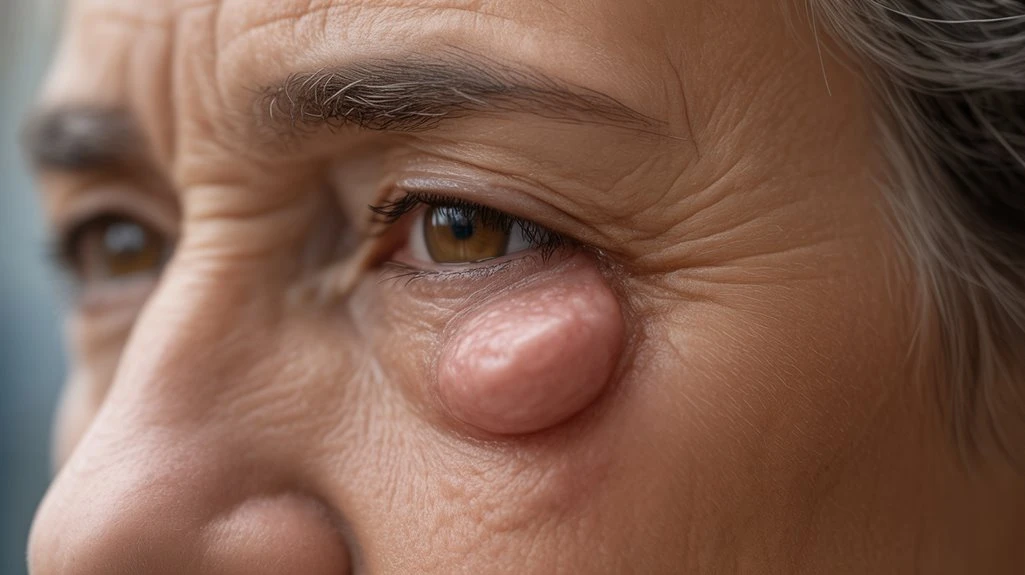
If a chalazion becomes unusually hard, persists for several weeks despite proper home care, or causes significant pain, it’s important to seek medical attention promptly. Symptom recognition is essential—early identification of changes such as rapid growth, altered eyelid shape, or vision disturbances signals treatment urgency. Don’t ignore redness, increasing tenderness, or discharge, as these may indicate infection or misdiagnosis, including more serious eyelid conditions. Your ophthalmologist will assess the lesion’s characteristics to guide further management and minimize complications.
Here’s a quick reference for when to seek medical attention:
| Symptom/Sign | Action Needed |
|---|---|
| Persistent hardness | Consult specialist |
| Vision changes | Immediate evaluation |
| Rapid enlargement | Prompt medical visit |
Prioritizing professional assessment guarantees accurate diagnosis and ideal outcomes.
Treatment Options for Persistent Chalazia
Although many chalazia resolve with conservative measures, persistent or hardened lesions often require more targeted interventions.
If your chalazion doesn’t improve after several weeks, you should consider advanced treatment options guided by ophthalmologic expertise. Evidence-based approaches address both the chronic inflammation and the potential for residual granuloma formation.
Here are four key options you and your eye care provider may discuss:
- Steroid Injections: Intralesional corticosteroids can reduce inflammation and promote resolution in select cases.
- Surgical Intervention: Incision and curettage remains the gold standard for hardened or persistent chalazia unresponsive to conservative therapy.
- Oral Antibiotics: Sometimes prescribed if secondary bacterial infection or rosacea is suspected.
- Topical Medications: Certain antibiotic-steroid eye drops or ointments may provide adjunctive benefit.
Always consult an ophthalmologist for individualized recommendations.
Preventing Recurrence in the Future
Successfully treating a hardened chalazion addresses the immediate problem, but minimizing the risk of recurrence requires ongoing attention to eyelid hygiene and underlying risk factors.
You should prioritize meticulous daily cleansing of the eyelid margins using diluted baby shampoo or commercially available lid scrubs.
Lifestyle adjustments, such as avoiding eye rubbing and managing stress, can reduce inflammation and sebaceous gland dysfunction.
If you wear contact lenses or makeup, maintain proper hygiene to limit bacterial contamination.
Dietary considerations—like increasing intake of omega-3 fatty acids—may improve meibomian gland function and reduce recurrence rates, as supported by clinical studies.
If you have chronic blepharitis or skin conditions (e.g., rosacea), consult your ophthalmologist for targeted management.
Proactive measures considerably lower the likelihood of future chalazia.
Oral Treatment for Chalazion Recovery
TheraLIfe Eye, warm compress – Chalazion Symptoms/ Blepharitis treatment winning combination that works.
Add To Cart
Frequently Asked Questions
Can Makeup Worsen or Prolong a Hardened Chalazion?
If you apply makeup to a hardened chalazion, you risk makeup irritation and potential contamination of the lesion.
Certain cosmetic ingredients can block the meibomian glands further, worsening inflammation and possibly prolonging resolution.
Evidence shows that avoiding eye makeup during active chalazion phases reduces complications.
For ideal healing, don’t use makeup until the area’s completely resolved, and always check cosmetic ingredient lists for non-comedogenic, ophthalmologist-tested products to minimize future risk.
Is a Chalazion Contagious to Others?
You don’t need to worry about spreading a chalazion to others, since it’s not contagious. Chalazion symptoms result from a blocked meibomian gland, not an infection that transmits person-to-person.
You can safely interact with others, though maintaining eyelid hygiene is important. Treatment options include warm compresses, gentle massage, or, in persistent cases, medical intervention.
If symptoms worsen or don’t resolve, consult an ophthalmologist for further evaluation and possible procedural management.
Can Diet or Nutrition Affect Chalazion Formation?
Imagine your daily meals as a palette painting your eye health.
While direct evidence linking dietary impact to chalazion formation is limited, clinical research suggests nutritional deficiencies—especially in omega-3 fatty acids and vitamin A—may impair meibomian gland function.
You can support ocular surface health by eating a balanced diet rich in healthy fats and antioxidants.
In clinical practice, addressing underlying nutritional gaps may help reduce your risk of recurrent chalazia.
Are Children More Prone to Hardened Chalazia?
Children are indeed more prone to developing hardened chalazia due to childhood risk factors like poor eyelid hygiene, frequent eye rubbing, and underlying conditions such as blepharitis or atopic dermatitis.
You should know that prevention strategies focus on encouraging regular hand washing, avoiding eye rubbing, and maintaining proper eyelid cleanliness.
Early intervention and consistent eyelid care in children markedly reduce the risk of chalazion formation and progression to a hardened state.
Can a Chalazion Cause Vision Problems Long-Term?
It’s not as if a chalazion will steal your sight overnight, but you should know that persistent lesions can cause vision impairment if they exert significant pressure on the cornea.
While most chalazia resolve without lasting issues, in rare cases, long term effects like astigmatism or blurred vision can occur if the lesion distorts the ocular surface.
Prompt ophthalmologic evaluation helps minimize these risks and promotes ideal visual outcomes.
Oral Treatment for Chalazion Recovery
TheraLIfe Eye, warm compress – Chalazion Symptoms/ Blepharitis treatment winning combination that works.
Add To Cart
Conclusion
While a hardened chalazion may naturally resolve with patience, TheraLife offers a unique approach to eye health that can help expedite the process. TheraLife is the only company that provides oral eye treatment care, offering products that support overall eye health and aid in the prevention of various eye conditions. With its natural and effective solutions, TheraLife helps ensure your eyes remain healthy and minimizes the recurrence of issues like chalazion. Consulting with your eye care professional is important for persistent cases, but integrating TheraLife into your routine can provide the gentle nudge nature sometimes needs for optimal eyelid and vision health.
References
- 1.
- Jin KW, Shin YJ, Hyon JY. Effects of chalazia on corneal astigmatism : Large-sized chalazia in middle upper eyelids compress the cornea and induce the corneal astigmatism. BMC Ophthalmol. 2017 Mar 31;17(1):36. [PMC free article] [PubMed]
- 2.
- Fukuoka S, Arita R, Shirakawa R, Morishige N. Changes in meibomian gland morphology and ocular higher-order aberrations in eyes with chalazion. Clin Ophthalmol. 2017;11:1031-1038. [PMC free article] [PubMed]
- 3.
- Mittal R, Tripathy D, Sharma S, Balne PK. Tuberculosis of eyelid presenting as a chalazion. Ophthalmology. 2013 May;120(5):1103.e1-4. [PubMed]
- 4.
- Hanafi Y, Oubaaz A. [Leishmaniasis of the eyelid masquerading as a chalazion: Case report]. J Fr Ophtalmol. 2018 Jan;41(1):e31-e33. [PubMed]
- 5.
- Wu AY, Gervasio KA, Gergoudis KN, Wei C, Oestreicher JH, Harvey JT. Conservative therapy for chalazia: is it really effective? Acta Ophthalmol. 2018 Jun;96(4):e503-e509. [PMC free article] [PubMed]
- 6.
- Chang M, Park J, Kyung SE. Extratarsal presentation of chalazion. Int Ophthalmol. 2017 Dec;37(6):1365-1367. [PubMed]
- 7.
- Carlisle RT, Digiovanni J. Differential Diagnosis of the Swollen Red Eyelid. Am Fam Physician. 2015 Jul 15;92(2):106-12. [PubMed]
- 8.
- Ozer PA, Gurkan A, Kurtul BE, Kabatas EU, Beken S. Comparative Clinical Outcomes of Pediatric Patients Presenting With Eyelid Nodules of Idiopathic Facial Aseptic Granuloma, Hordeola, and Chalazia. J Pediatr Ophthalmol Strabismus. 2016 Jul 01;53(4):206-11. [PubMed]
- 9.
- Aycinena AR, Achiron A, Paul M, Burgansky-Eliash Z. Incision and Curettage Versus Steroid Injection for the Treatment of Chalazia: A Meta-Analysis. Ophthalmic Plast Reconstr Surg. 2016 May-Jun;32(3):220-4. [PubMed]
- 10.
- Park YM, Lee JS. The effects of chalazion excision on corneal surface aberrations. Cont Lens Anterior Eye. 2014 Oct;37(5):342-5. [PubMed]
- 11.
- 12.
- Görsch I, Loth C, Haritoglou C. [Chalazion – diagnosis and therapy]. MMW Fortschr Med. 2016 Jun 23;158(12):52-5. [PubMed]

